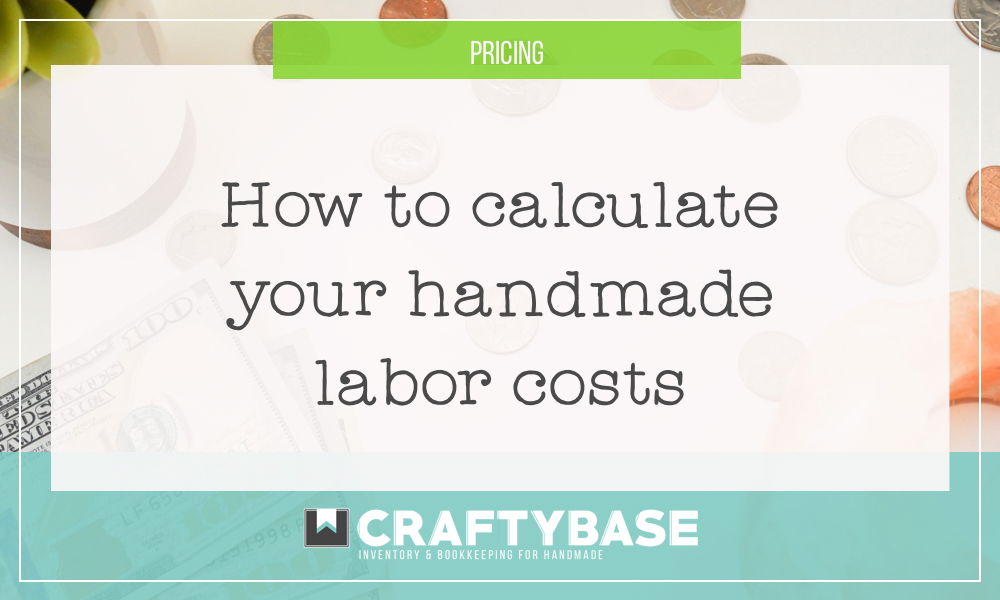How to calculate your handmade labor costs
How to calculate your labor costs, including what rate you should charge for your handmade work.

One of the biggest pricing mistakes craft sellers make is that they completely ignore their own labor costs.
Being self-employed, it’s easy to undervalue or completely ignore the time you put in to your business.
In this article, we’re going to show you how to calculate your handmade labor costs so you can price your products correctly.
Need to get your raw material and product inventory under control?
Try Craftybase - the inventory and manufacturing solution for DTC sellers. Track raw materials and product stock levels (in real time!), COGS, shop floor assignment and much more.
It's your new production central.
So what is “labor”?
Let’s start with what labor is. It’s everything you do to create and ship your product. It includes:
-
brainwork (designing, sourcing materials, planning)
-
making the actual product
-
photographing it
-
listing it in your shop
-
packing and shipping it to the customer
That’s a lot of hidden time right there, and if you aren’t in some way accounting for it, you are leaving money on the table!
Why is it important to track labor?
Your labor is a key part of your pricing strategy as it allows you to factor in an amount you would ideally like to pay yourself.
Without allocating a set proportion of your profits to your wage, you’ll need to rely on taking this amount from the overall business profits. This can be dangerous, especially if your pricing strategy isn’t completely factoring in your costs of production and hidden costs like overheads.
The other big reason why it’s important to separate your wage from your business profits is to ensure that your business has the funds to grow. If you need to draw everything the company makes each year, this leaves nothing in the bank for any planned or unexpected investments you might need to make for your business future.
The handmade labor pricing formula
To determine your labor cost, the formula per product you’ll want to use is:
Manufacture Time
This first part of the equation is how long it actually takes you to make the product being sold. You’ll want this to be as accurate as possible, but there is some leeway. For handmade goods that are all unique, it can be difficult to pinpoint an exact time. In general, you should aim for an estimate that’s on the high side.
To help you estimate the time, break down each step of the manufacturing process into smaller tasks and time yourself completing those tasks. Once you have a good idea of how long each task takes, you can start to put together an overall estimate for each product.
Remember to also factor in any time spent on pre-production tasks like sourcing materials, planning, and design work.
Hourly Rate
This is the hourly rate you pay yourself for your time and expertise. This can be a difficult number to calculate, as it’s not just based on your time but also on your skillset and experience.
It can also be helpful to consider what you would need to earn per hour to cover your living expenses. This number will be different for everyone, but it’s a good starting point for setting your hourly rate.
So, what’s a good hourly rate for a handmade seller?
It’s understandably tricky to decide on a hourly rate as you are your own boss and only you do know exactly what you do. As a ballpark, you’ll want to try and ensure that you set a rate that is more than federal minimum wage. As of 2019, in the US this is federally mandated since 2009 as $7.25 per hour. Each state then has it’s own minimum hourly wage that can vary between $6.55 and $14.
Another way to do this is to figure out a ideal base salary that you would like to ideally draw from the business and work backwards from here by dividing this salary by the total number of hours you plan on working in the year.
For example, if you would like a salary of $45,000 and you estimate you will work on average 40 hours a week on your business (with 2 weeks of holiday/sick time), then your target hourly rate will be:
$45,000 ÷ (40 hours x 50 weeks) = $22.50.
If you have no idea of the salary you would like, one way of narrowing this down is to look at a salary comparison site like Glassdoor for occupations similar to your primary craft focus in your local area. For example, “hand sewers” in Denver in 2019 currently demand a salary between $21,000 and $32,000. Jewelry creators in New York have an estimated salary band of $39,000 - $60,000. Keep in mind that these salary estimates usually include additional compensation like healthcare and bonuses.
Calculating your labor cost on your handmade items
Putting this all together to figure out your labor cost, if you decide on an hourly rate of $12 and it takes you half an hour to make your product, this would be a total labor cost for the product of $6.
Our improved Etsy pricing formula factors your labor costs to ensure that you remember to cover your own wages outside of your business profits.
The beauty of the formula is that you can either decide to include it as a separate amount or just factor it into your profit margins via the markup - it’s up to you!
Introducing Craftybase: Your Pricing Friend
Craftybase is inventory and pricing software designed for small makers. Craftybase features the ability to log each batch you create along with the time it took you.
This means that you can easily track your average production time for each product and keep on top of your labor costs with ease. Simply add a new log whenever you start making a new batch - it couldn’t be simpler. Start a free 14 day trial to see how it can help with your handmade pricing!
